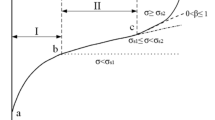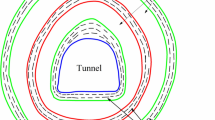Abstract
A non-Euclidean continuum model for the descriptions of the elastic stress-field distributions and fractured zones in the surrounding rock masses around the deep circular tunnels subjected to nonhydrostatic pressure are established. In the non-Euclidean continuum model, the elastic stress-field distribution of the deep surrounding rock induced by compatible deformation of non-fractured zones and incompatible deformation of fractured zones is determined. The wavy behavior of the stress components based on the non-Euclidean model are obviously different from that of the stress components which have extrema on the working contour and tend monotonically to the value of the in-situ stress at infinity in rock masses within the framework of the classical model. Mohr-Coulomb criterion is applied to research the occurrence of disintegration zones. Disintegration zones appear when the stresses in deep rock masses reach a certain critical value. It is found from the numerical results that the magnitude and site of fractured zones depend on the value of in-situ stress and non-Euclideanness parameters.
Similar content being viewed by others
References
D. R. Cloete and A. J. Jager, “The nature of the fracture zone in gold mines as revealed by diamond core drilling,” Association of Mine Managers, Papers and Discussions (1972–1973).
G. R. Adms and A. J. Jager, “Retroscopic observations of rock fracturing ahead of stope faces in deep-level gold mine,” Journal of the South African Institute of Mining and Metallurgy, 80, No. 6 (1980).
E. A. Tropp, M. A. Rozenbaum, V. N. Reva, and F. P. Glushikhin, “Disintegration zone of rocks around workings at large depths,” Preprint No. 976, Yoffe Physicotech. Inst., Acad. of Sci. of the USSR, Leningrad (1985).
E. I. Shemyakin, G. L. Fisenko, M. V. Kurlenya et al., “Disintegration zone of rocks around underground workings. Part 1: Data of full-scale observations,” Journal of Mining Science, No. 3 (1986).
E. I. Shemyakin, G. L. Fisenko, M. V. Kurlenya et al., “Disintegration zone of rocks around underground workings. Part 2: Rock fracture on models from equivalent materials,” Journal of Mining Science, No. 4 (1986).
E. I. Shemyakin, G. L. Fisenko, M. V. Kurlenya et al., “Disintegration zone of rocks around underground workings. Part 3: Theoretical concepts,” Journal of Mining Science, No. 1 (1987).
E. I. Shemyakin, M. V. Kurlenya, V. N. Oparin et al., “Disintegration zone of rocks around underground workings. Part 4: Practical applications,” Journal of Mining Science, No. 4 (1989).
S. P. Li, “Observation report of Anchor test in roadways of Quantai coal mine-and discussion on new viewpoint of anchor characteristics and parameter selection,” Journal of China College of Mining [in Chinese], 8 No. 4 (1979).
Y. N. He, “Analysis of loose zone around the roadway in soft rock,” Journal of China Coal Society [n Chinese], 16,No. 2 (1991).
Z. L. Fang, “Support principles for roadway in soft rock and its controlling measures,” in: Soft Rock Tunnel Support in China Mines: Theory and Practice [in Chinese], China University of Mining and Technology, Beijing, (1996).
V. N. Reva and E. A. Tropp, “Elastoplastic model of the zonal disintegration of the neighborhood of an underground working,” in: Physics and Mechanics of Rock Fracture as Applied to Prediction of Dynamic Phenomena. Collected Scientific Papers [in Russian], Mine Surveying Inst., Saint Petersburg (1995).
Q. H. Qian, “The key problems of deep underground space development:,” The Key Technical Problems of Base Research in Deep Underground Space Development: The 230th Xiangshan Science Conference [in Chinese], Beijing (2004).
Q. H. Qian, “The current development of nonlinear rock mechanics: the mechanics problems of deep rock mass,” in: Proceedings of the 8th Conference on Rock Mechanics and Engineering [in Chinese], Chinese Society for Rock Mechanics and Engineering (Ed.), Science Press, Beijing (2004).
X. P. Zhou and Q. H. Qian, “Zonal fracturing mechanism in deep tunnel,” Chinese Journal of Rock Mechanics and Engineering [in Chinese], 26,No. 5 (2007).
X. P. Zhou, F. H. Wang, Q. H. Qian, and B. H. Zhang, “Zonal fracturing mechanism in deep crackweakened rock masses,” Theoretical and Applied Fracture Mechanics, 50,No. 1 (2008).
M. A. Guzev and A. A. Paroshin, “Non-Euclidean model of the zonal disintegration of rocks around an underground working,” Journal of Applied Mechanics and Technical Physics, 42, No. (2001).
Author information
Authors and Affiliations
Additional information
__________
Translated from Fiziko-Tekhnicheskie Problemy Razrabotki Poleznykh Iskopaemykh, No. 1, pp. 42–52, January–February, 2011.
Rights and permissions
About this article
Cite this article
Qian, Q., Zhou, X. Non-euclidean continuum model of the zonal disintegration of surrounding rocks around a deep circular tunnel in a non-hydrostatic pressure state. J Min Sci 47, 37–46 (2011). https://doi.org/10.1134/S1062739147010059
Received:
Published:
Issue Date:
DOI: https://doi.org/10.1134/S1062739147010059




